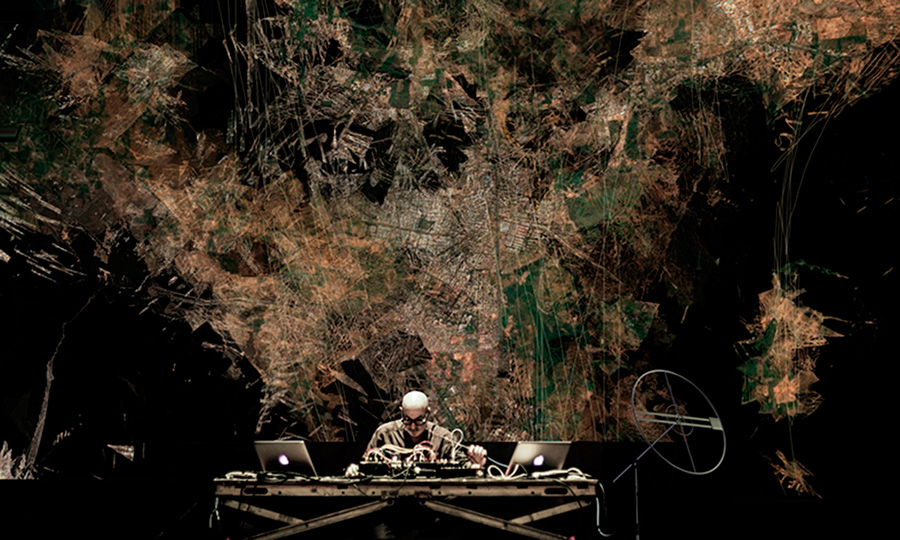1. On matter | on visibility
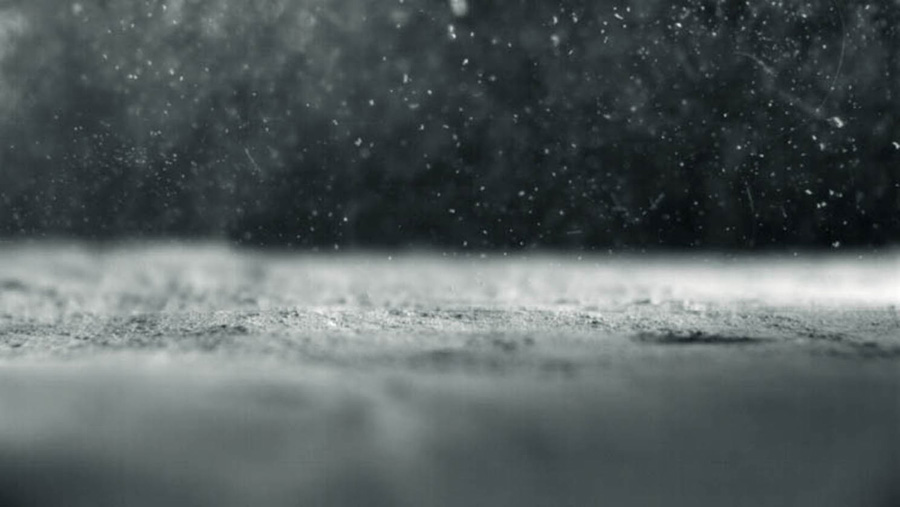
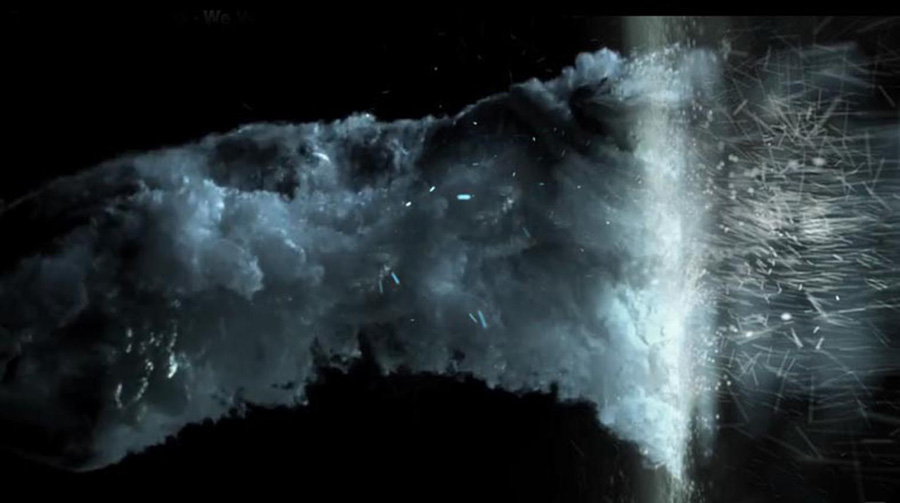
In contemporary audiovisual performance and installation scene, in my opinion, there are two tendencies: an internal organic line in which sound and image are organized in order to outline a narrative perspective and, on the other hand, an external organic line, in which the materials operate towards abstraction. The two perspectives do not necessarily contradict each other but, rather, tend to link together. Could you speak about this tension on narrative/abstractive dimension in your work?
In my work compositional abstraction and narrative coexist without friction, they are developed from common elements and then take different paths or directions according to the trajectories which they impart to each function.
I conceive of sound and image in the same way: to obtain a single homogeneous material that can be absorbed by the audience on an emotional level, thus bringing the technology used in the background. Sound and image, in this sense, are my dynamic material; they are palpable, have a density, porosity, elasticity of time. Their common feature, in this sense, is that they are two materials that are developed and modified in the same space-time.
This is essential to develop an audiovisual language that is not simply the sum of sound and image, but that is the result of a series of assemblages and internal resounding materials. This temporal trajectory ties them intimately, in order to assign a force impact on the viewer so powerful that it penetrates his perceptual system. Despite inhabiting the body via different channels – traditionally through sight and hearing – it is in the display of the senses and emotions of the audience that the sound and image merge and fall apart, like a prism, to touch their perception.
The narrative trajectory is more or less determined by those who made up the performance, in this sense it may indeed be regarded as a subliminal dimension: at the level of composition, its degree of impact with the viewer may be designed. The materials are thus used in a way that enables the development of this intrinsic potential.
That being said, most of my work is one part abstraction and one part storytelling. Their relationship corresponds to some extent to the functioning of our structured thinking that is constantly pushed and supported by irrational thoughts – or even abstract impulses – which call the mind. All this cohabitates symbiotically without creating imbalances, but rather it creates a particular ecosystem perfectly balanced. Though something, at first glance, may seem abstract – like a pulse that you cannot decipher immediately – this does not mean that there is, inside a hidden meaning, a narrative path that they may develop, or bring out, conversely, decide to leave hidden. The composition is as if something passed through me, then it finds a sense of autonomy beyond the directions that can give my speech at work.
In this framework, I would like to introduce another important point: the notion of organic materials. In your works, there are many materials as blood – I’m referring in particular to Inject (2009) – or Dust (2010), for example. Could you clarify this important principle?
I am interested in working with living matter. By this I do not only refer to living things in the proper sense, but also to what is changing, in an evolutionary sense. In every work I strive to have the raw material with which I am confronted with as autonomous, self-sufficient. It is therefore a matter that has its own intrinsic impulsiveness with which I find common ground: I may use thisenergetic identity to lean towards creative impulses that can be contradictory or similar to its original quality. This attraction to the organic is not premeditated; it comes, instead, in a natural way, the sensitivity with which I perceive life. What interests me – at the heart of this belief – is the size of evolution of things, their ability to maintain tension and constant change.
One aspect particularly appeals to me: working with a form of magnification of things which allows me to understand what are the steps, from a number of factors, well organized and structured, which lead to the design of systems that are far more detailed and unique. I am interested in shaping unreal worlds, organizing them into a truthful proposition. It is here, at this point that the relationship between the visual and sound elements becomes a palpable tension, a sulphuric pressure…
…in this context, can you speak about the composition process behind Dust?
Inspired by the photo of Marcel Duchamp and Man Ray – Elevage de poussière (1920) – Dust proposed an exploration inside a particular matter: dust. From the threshold of imperceptibility, some pigments are suspended around a magnetic field. They are organized in random fibrous networks and have become one of the compositions of hypnotic complexity: real webs, diagrams of powder. The particles of sound, associated with the bright images, are treated here on a scale which will clears all references, and any system of recognition is sidelined. We are inside the matter, in an unequivocal manner. Dust is a link between the invisible and the visible, where the dust itself becomes a vertigo and produces, on the surface of the video, a visible accumulation as X-ray: crossing the threshold of visibility you plunge into the dust, in its fibres in its deep structure. In this project I tried to give shape to this process. I worked so closely with the matter that a pile of dust became for me a very complex system, capable of detecting other areas of dust as articulated universes. With this process were developed a particular notion of time, that is perfectly present in the work. The matter becomes very similar to an organic elastic band that stretches and contracts. Tension reveals details that at first sight seemed non-existent.
At the moment, to provide another example, I am working with wind. For me, wind is a material, even thought very dynamic and volatile, which exceeds my understanding and my expectations, because if you just add an obstacle to the device – a cylinder, a perforated wall – all the internal turbulence is affected. Thus I am trying to exploit this wind power as an artistic material.
In Stochastic Process (2010), I worked in the direction of pure abstraction, both in processing visual and audio materials. Enclosed in a black space, a sound source holds in suspension light projected dust. The dynamic tension that produces the sound has a direct effect on the gravity of microscopic dust. The geography of these particles is therefore influenced by the variations that produce random breaks, sudden flow or, conversely, promote the formation of the highly organized material, which is called, precisely, the Stochastic Process.
This perspective about a dusty material concerns also the composition of another device: Stethoscop (2013), a “cellule” of Dust accumulation. Could you speak about the role of the audience in this work?
Moving images of microscopic dust are projected onto an HD video screen. By sliding a stethoscope’s chest piece across the video membrane, the viewer will be able to hear nuances of sound emitted by the dust clusters. Through audio-geographic distribution, the sound nuances will interact with the position of the stethoscope and that of the video image.
I have created some installations around the Dust’s project: Dust accumulation. In this work, my aim is to make the audience enter into the matter. The dust is conceptualized following two of its qualities: on one hand, by using its visual powerful energy, on the other hand, by playing with its sonorous dimension. I set up different audio and visual microscopic systems, and thanks to them the audience could be in contact with this dust material. Such experience is almost unthinkable nowadays, since we live in an increasingly aseptic environment, and we want to eliminate and evacuate at all costs any trace of this ugly dust. Stethoscop and Dust Restriction are good examples from this installation. In Stethoscop I wanted the viewer to be surprised in exploring the dust becoming a pictorial beauty, and I decided to give him the possibility to cross this microscopic dust with a stethoscope. I wanted the audience to investigate a microclimate and the sound turbulences that stimulate a dusty tension. Dust restriction represents another approach, because the installation is divided in two connected parts. The first confronts the viewer with images of microscopic dust broadcasted throughout a tubular optical nerve: telescopic microscopes. Spectators cannot focus their eyes because this dust is energetically unstable. I designed it this way in order to excite the retina and give the viewer an impalpable immersion. Throughout a long and narrow corridor are displaced several optical tubes like that, and when the audience finally reaches the end of the corridor, it must pass through a little space to go to the second room of this installation, and on the other side they faces a huge image MACROSCOPIC (13 @ 15m) of dust released very slowly, in contrast to the miniaturization of optical nerve produced in the corridor. I wanted to confront the viewer with two types of energy. Once again a tension due to the territory: microscopic / invisible and macroscopic / fully visible.
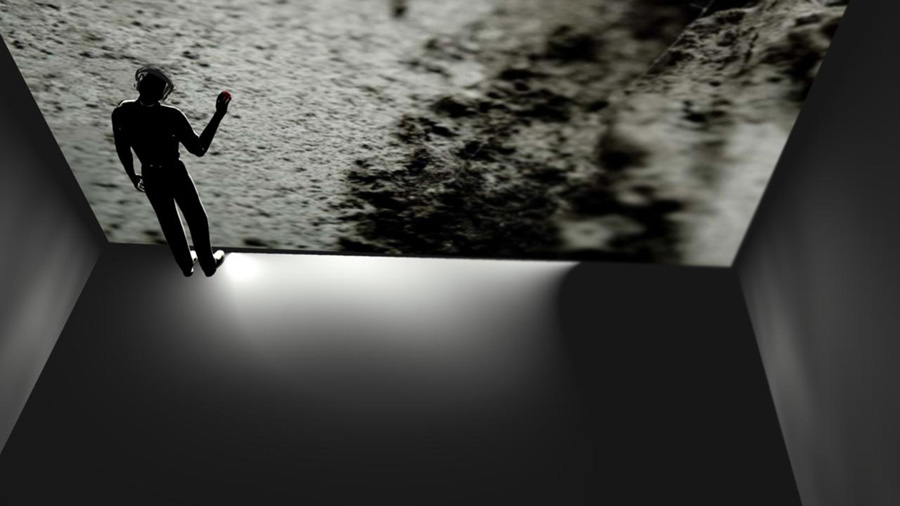
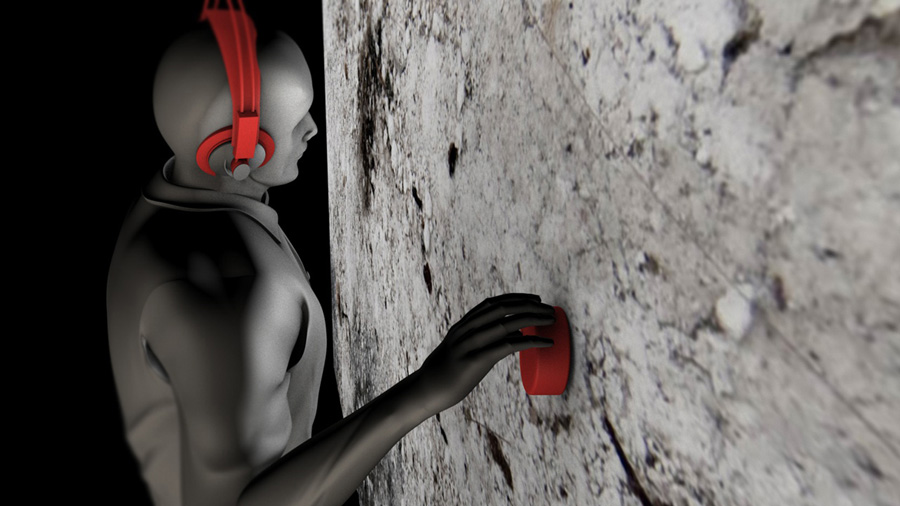
2. The state of matter
These projects opens to another notion: the change in state of the matter. This process involves the possibility of a visible and audible intensity that are not directly perceivable to the senses…
…I’m interested in making perceptible elements that somehow escape our attention. It fascinates me to give a form to what the eye cannot capture. I often think of things: if an object is a solid volume, it is because of all the tension that maintains a state of apparent repose. If you alter this balance, these bonds break up and the object simply becomes matter with volatile energy. A friend of mine, who melts glass at high temperatures, is in daily contact with this change of state of matter caused by the molecules of glass subjected to heat. So, intervening with an external element on an object, we can drastically change its physical structure. This brings me, inevitably, to reflect on emotions and human perceptions: simply insert a disturbing element in someone’s life and all its equilibrium can be threatened. Inject is the extreme case of this step.
Could you speak about the importance of the notion of form in your works, for example, in Overlapp (2012) or in Inject (2010),with audience in the water ?
My project Inject is a good example for my preoccupation about form and audience immersion. It was the end of 2008 when I initiated the Inject project. The genesis of the principal visual material for it was a shoot, in an immense cistern filled with water, which lasted six consecutive days. Yso, a Cambodge man from Montreal, had to be immersed for over eight hours a day in the glass tank, oscillating between weightlessness and lack of oxygen. With the help of various digital video recording and photographic systems, I assembled many series of temporal sequences, images that has been then assembled into a flexible and visual modular body. One of the great particularities of Inject, was the pre-production phase. Many cares were taken to put images captors and movement detectors all together in a digital bank, so that they would build some micro segments of the performance. Following this idea of putting audience in a more adequate context than a standard venue or a theatre, I presented Inject in a swimming pool with all the audience swimming in the water, underling a direct connection between my content and the audience bodies. In this situation they were physically and psychologically destabilized, and they identified with the man in the cistern. They feel the real water on their flesh, they was also near naked like Yso. To enhance the experience I was using 2 sound systems: a first one underwater and another above the water, in order to disseminate more accurate frequencies, and the more musical contents as possible.
In a different perspective, we are surrounded by various forms manifesting in so many ways even in our everyday life. For example, there are a lot of magnetic waves around us, more and more. And they affect our behaviour, our psychology and our bodies. They are part of our intimacy, something like an inner territory. Overlapp conveyed by these impulses, by these reflections. It’s a zoom-in between Different train (2010) and Dust. It’s an urban impressionistic vision focusing on microscopic particles. In 2010 during my stay in Asia when Korea was hit by typhoon, I was able to film the images that eventually became the source for the video. The city was engulfed in suspended dust.

You mentioned the idea of territory, could you develop this analysis around different territories focusing on the composition of Geographic Words (2012) or Eotone (2013) ?
Beyond the notion of visible/invisible and concepts such as form or tension, I am also interested in the idea of territory: the territory that influences human beings and their behaviour. A territory that may be distant like that presented in Eotone, with its wind, or in Seisik with its land vibrations; but also a territory that may be much closer and microscopic like in Dust or the one produced by magnetic flux as in a new project called Kathodd. A territory is this powerful, invisible and sometimes microscopic force of the elements around us. It is a force that is at rest for most of the time, inoffensive. But it possesses an immense power. When the wind rages or the earth cracks. Just think of the earthquake in Japan, it has caused a tsunami, and the tsunami struck a nuclear plant causing a disaster. We are so small in front of such a force. We are even naïve and blind. Like in front of the death. We don’t want to think that if elements exceed their level of tranquillity, we are lost. Why do so many people continued to inhabit the San Andreas Fault even if they are aware that in 20 or 100 years it will tear into pieces California… Sooner or later.
It makes me think a lot. It is invisible to them, so they do not think about it… As if it will never happen.
In Geographic Words I took advantage of the intimacy produced by a small venue, and the audience’s proximity represents an inspiration for the work. I create an audio geographic performance that imagines the audience as a sonic territory to be navigated, explored and integrated into the performance. Everything begins with a woman walking confidently alone in the middle of the night in some places like a no man’s land. She has a very sensitive and whispered voice that unveils her path. I’m in the middle of the room with spectators around me, and some of them hold mini-loudspeakers in their hands. In this sense, I create sonic atmospheres that integrate with or rupture the intimacy of the disembodied voices emanated from the mini-loudspeakers located within the audience. These atmospheres, emanating from a second sound system at the room’s periphery, create a sonic envelope that surrounds me and the spectators at the same time. Words, phrases, and disembodied and temporally dislocated poetic narratives in two languages mingle within this atmosphere of domestic and abstract sounds to take flight across an evocative yet ambiguous territory of emotion and meaning, where the spoken and the heard become an experience.
Once again this is a composition that put together an intimate territory and a more distant territory: it is a cinematographic work, but without image.
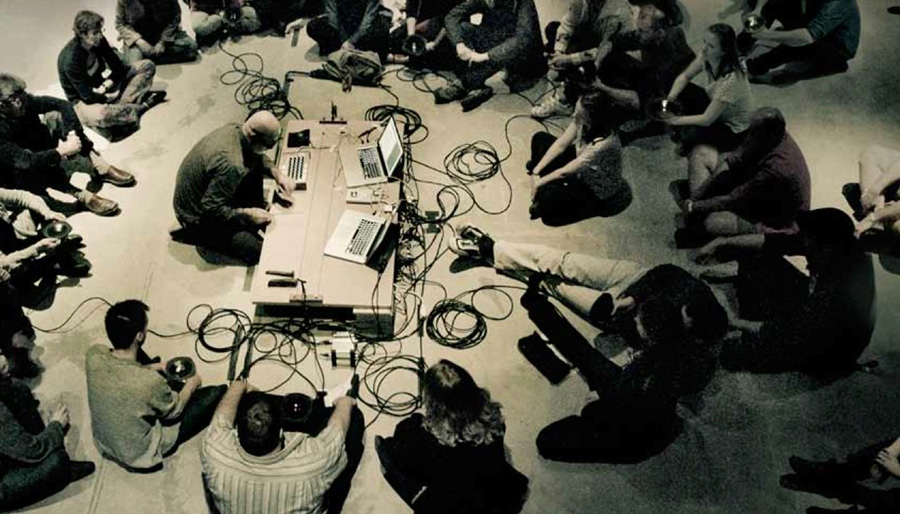
In a different perspective, with Eotone – a kinetic, sound and generative urban installation – I collaborated with David Letellier. We have reflected about distance and weather, by staging something intangible yet powerful: the wind. Four sound and sculptural diffusers, containing elements of both the weather vane and the fog horn, make up this monumental installation that renders in movement and sound the direction and force of the wind blowing simultaneously on two continents: Montreal and Quebec City on one side, and the Atlantic, in Rennes and Nantes on the other. The wind data recorded in each city is transmitted live to the diffusers, controlling the orientation of each of the structures and orchestrating the combined chords that make up the harmonic whole perceived at the heart of the installation. By transforming weather data into sound, Eotoneoffers a subtle artistic vision of the internet of objects.
3. At the limit of audible dimension
So we are exposed to an x-ray view of the material, an idea that represent a key principle of your work. In this sense, the performances Seismik(2014) and Aftershok (2014) seem to me a perfect representation of the structure that makes up reality, a link manifested in the form of light and sound pulses. This brings into play a works infinitely large in their size, as well as those infinitely small, which have an important role in your compositions. Could you speak about it ?
When we enter the space-time inside the invisible matter, our whole perception changes, we look for a new position. This means that we can work – with the support of technology – on an infinitely small time scale, almost to the point where time seems to stop (freeze system). When everything seems still and we approach the smallest particle of matter, we realize that this too, despite everything, is constantly moving and looking for a dynamic relationship with the environment.
Seismik is inspired by geodetic phenomena’s, frictional sidings, fossil earthquakes and the geological model. This work uses stress fields to provoque tension between vertical layered dislocations. Using the seismic-data of our planet territories, I create, with this new work, nervous stratigraphic audiovisual motifs.
Seismik and Aftershok are two different examples of this new power concerning the perceptive activity. They invite us to take a multisensory leap into the unknown, where sedimentary friction, magnetic waves, rumbling matter, abstractions and other motifs clash and collide against a backdrop of visual and sonic dislocations. With its dazzling dislocation models of strain and release, Seismik is a tension-charged, frequency-fraught performance that taps into seismic waves, frictional resistance and tremor-related phenomena in real-time. Once again, I try to render the invisible visible.
…Aftershock is a performance inspired by the consequences of several brutal topological shocks, and it explores the ambiguity of a new landscape…could you speak about this performance and its conceptual and aesthetics elements ?
Aftershock is an audiovisual performance that can be presented in solo or with an orchestra. This work is inspired by the consequences of several brutal topological shocks. Exploring the ambiguity of realism in post-human landscapes, I have created three-dimensional simulations through the instability of dynamical systems and converted them into large-scale cinematic visuals. During the performance, I build multi-layered audio sedimentations that emphasize this cartography of catastrophe. I also develop a digital argentic process that confers a post-seismic aesthetic on my work. On stage, I can perform solo or with live musicians hailing from the host countries, who follow my graphic score.
Toward which direction is developing your new creations, and what are the main aspects, for example, of Opposite winds (2015) ?
This installation / performance is part of my series Windfields, dedicated to wind forces. It is composed of two turbines face to face and a wind sensor in the centre. They are connected to a computer via wi-fi. This contradictory and opposite force produces a feedback of almost uncontrollable wind. This is a more raw experience connected to the force of elements.
The redefinition of the notions of listening and vision in your work brings me to speak of an immersion in the audiovisual environment. This immersion has a meditative quality: the body of the audience is inside the audiovisual space. The body of the listeners is crossed by the sound, one way to explore our loneliness … Could you speak of this aspect about the strategies you employ for redefining the experience of listening and looking in your works, for example, in Immerson (2015), the project realized with Nicolas Bernier, John Duncan and Mika Vainio ?
This project was born last year at the invitation of the sound artist France Jobin ( i8u ). She develops with Stephane Claude (Head and Research_Audio Sector, New Media Lab) special listening devices at the Oborro centre in Montreal. The audience is asked to lie on the floor surrounded by a 6 channels sound system. Because their ears are near the floor, Stephane put each speaker to a very specific position creating a reflection to the floor just before reaching audience ears. This device produces acoustic phenomena, kind odd dual perception in some specific frequencies. So Nicolas Bernier, John Duncan, Mika Vainio and me were invited to create a piece for this immersive system. The fact that the audience is lying down gives to them more receptivity and concentration on our work. All this device pushes us further in a more intimate relation between audience, space and frequencies. The architecture of the sound reproduction system used for Immerson is perfectly consistent, in its design and tuning, with the idea of the project. Two of its design signatures are on one hand, the attention to the qualities of silence, and on the other, the extended sound preparation and installation periods, where curator, artists and sound engineer are engaged in conversations and experimentation with the system, the musical composition and the space. The system is a 6.1 surround immersive installation with small stereo speakers added on the ceiling for “shower” audio effects.
We use high quality mastering-grade full-range active studio monitors or smallish active sound reinforcement speakers. This design approach permits almost zero processing, very little EQing is done to the sound system, in relation to careful speaker arrangement positioned according to room geometries and their resonant properties and modes. We are investing in the direct sound coming from the 6.1 arrays placed close to the listeners, a full-bodied, balanced, solid and delicately detailed sound. The “spatialization” is accomplished with distributed mono or stereo elements and/or discrete audio channels, according to the artist’s needs. We use a circular isotropic floor arrangement for the speakers with an equidistant placement on the azimuth plane at every 60 degrees. The audience is comfortably lying on the floor on small mattresses; the speakers are at about 4 feet from the floor tilted toward the listener’s heads at about 14 degrees.
Although the speaker array is totally symmetrical, we enjoy multiple phenomena of floor to ceiling reflections. The presence of mattresses and bodies on the floor create subtle variations in the sound absorptions and reflections in the composed musical program, creating singular and individualized listening experiences for the audience.
Moreover, “spatialization” is done organically on site by the artists and/or the sound engineer at the console, but thanks to the nature of this setup, audio sources are also from time to time, moving on their own and appearing in directions outside of the azimuthal plane which enriches the experience tremendously.
